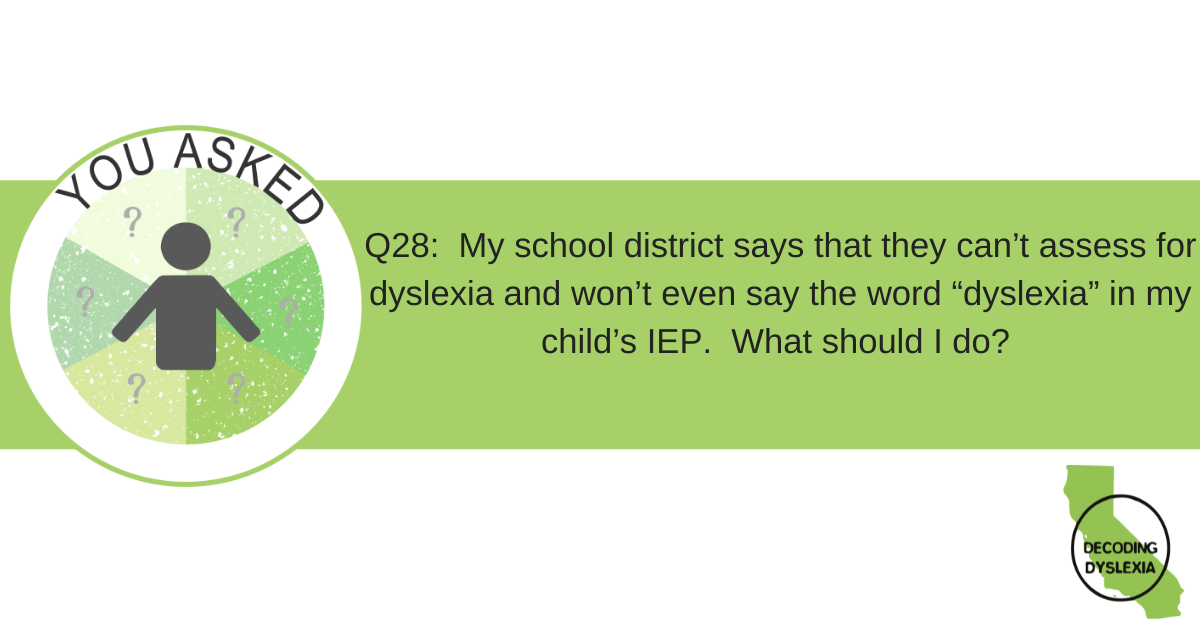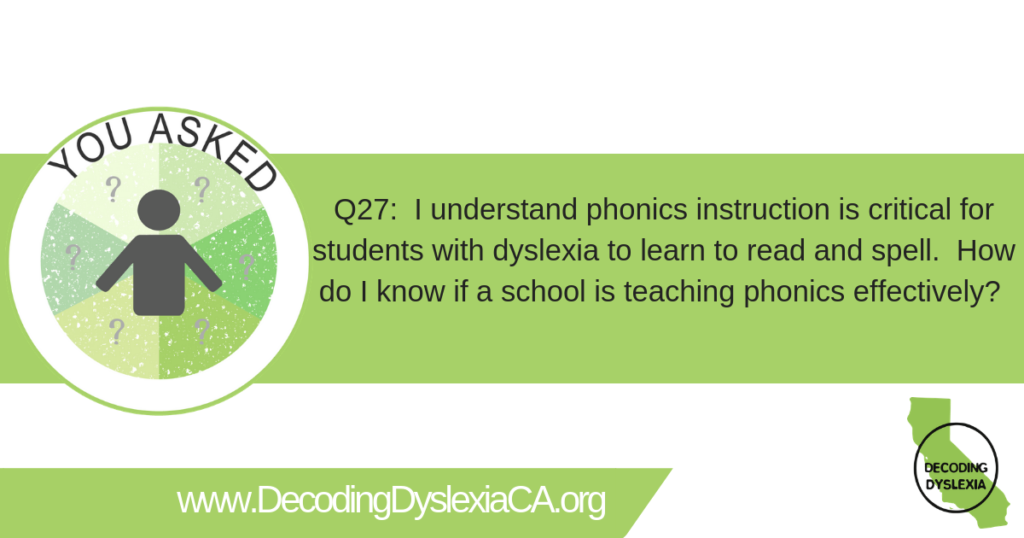Download a PDF version of this You Asked question and answer here.
Q28: My school district says that they can’t assess for dyslexia and won’t even say the word “dyslexia” in my child’s IEP. What should I do?
A: Yes, school districts can and should assess for dyslexia and use the term dyslexia in identifying the needs of a student. However, there is no law that says that they must use this term in the assessment process, and since dyslexia is a diagnosis under the DSM-5, if a school district says they cannot assess for “dyslexia” they may feel you are asking for a medical diagnosis. However, a school assessment to identify a reading disability such as dyslexia is different than a “diagnosis,” and you can still get the assessments done that will inform you and your child’s IEP team if your child is indeed dyslexic. Therefore, you should clarify that you want your child assessed for learning disabilities in the area of reading to see if they have characteristics of dyslexia. Under California law (5 CCR 56337.5(a)), it states:
“A pupil who is assessed as being dyslexic [emphasis and meets eligibility criteria specified in Section 56337 and paragraph (10) of subdivision (b) of Section 3030 of Title 5 of the California Code of Regulations for the federal Individuals with Disabilities Education Act (20 U.S.C. Sec. 1400 et seq.) category of specific learning disabilities is entitled to special education and related services.”
There were so many concerns were being raised by parents whose IEP teams refused to use the term dyslexia (and dysgraphia and dyscalculia) that the U.S. Department of Education, Office of Special Education and Rehabilitative Services wrote a Dear Colleague letter to state and local educational agencies dated October 23, 2015 clarifying that “there is nothing in the IDEA that would prohibit the use of the terms dyslexia, dyscalculia, and dysgraphia in IDEA evaluation, eligibility determinations, or IEP documents.” The letter goes on to state “OSERS further encourages States to review their policies, procedures, and practices to ensure that they do not prohibit the use of the terms dyslexia, dyscalculia, and dysgraphia in evaluations, eligibility, and IEP. Finally, in ensuring the provision of free appropriate public education, OSERS encourages SEAs to remind their LEAs of the importance of addressing the unique educational needs of children with specific learning disabilities resulting from dyslexia, dyscalculia, and dysgraphia during IEP Team meetings and other meetings with parents under IDEA.”
California Department of Education’s CA Dyslexia Guidelines provided more specific guidance stating on Page 55:
“An evaluation for dyslexia includes assessment in written language areas (e.g., reading, spelling, handwriting, written expression) that are characteristic of dyslexia: letter identification; letter–sound (grapheme–phoneme) associations; word identification-decoding of real and pseudo-words; reading fluency (i.e., accuracy, automaticity, and prosody); reading comprehension (sentence and passage levels); spelling (real and pseudo- words); and written expression (sentence and passage levels). The evaluation should include reading comprehension and written expression because they require higher-level organization, memory, and integration of skills for functional use and application.”
According to the California Association of School Psychologists’ Frequently Asked Questions- California Dyslexia Guidelines (Question #4):
“Can school teams assess for dyslexia? School teams can (and should) assess for. CDE Guidelines [CA Dyslexia Guidelines] discuss the critical characteristics that are indicative of dyslexia (see p. 53-58) noting that dyslexia can be identified in both general education and through a comprehensive evaluation that is part of a Special Education eligibility evaluation.
Since oral language is the foundation for building literacy skills, a comprehensive language-literacy evaluation should also include assessment of oral language skills (e.g., comprehension and production of spoken language in the areas of phonology, morphology, and syntax [form], semantics [content], and pragmatics/discourse [use]).
To make an accurate identification of dyslexia, the evaluator or evaluation team must also consider a student’s developmental and medical history (including vision and hearing screenings as well as medications), family and school history, teacher reports, self-reports, parent reports, social and emotional status, and current classroom performance.”
The California Department of Education did a “roadshow” to educate local education agencies (LEAs) about the CA Dyslexia Guidelines and to assure them that it was okay to use the term “dyslexia”. Slide #10 on the CDE presentation states this fact.
What does it look like in your student’s IEP?
When determining special education eligibility, most students with dyslexia will usually be found eligible under the umbrella term of “Specific Learning Disability” usually with identified deficits in “basic reading skills”, “reading fluency”, and/or “written expression”. Often, but not always, there is a deficit indicated in the basic psychological processing area of “phonological processing” (Refer to You Asked questions #4 and #14 for additional information on phonological processing).
As many LEAs use the Special Education Information System (SEIS), DDCA is including examples of Team Determination of Eligibility forms that may be helpful to engage the IEP Team in discussion regarding whether your child has characteristics of dyslexia. (Please note that individual LEA SEIS forms may be different and forms are updated periodically so ask your LEA for a copy of their forms.)
If these boxes are indicated on your child’s SEIS forms, the IEP team should be discussing and documenting whether or not dyslexia may be a concern (and dysgraphia if written expression deficits are indicated, and dyscalculia if mathematical deficits are indicated).
What to do if my school district still insists that can’t assess for dyslexia and can’t even say the word “dyslexia” in my child’s IEP?
First, so that your child can be assessed without delay, clarify that you want a comprehensive psychoeducational assessment, and that you are concerned about your child’s deficits in reading. Then, ask your Special Education Director for your school district in writing (with proof of delivery) for Prior Written Notice (PWN) of the school district’s policy that states they are not allowed to assess for or use the term dyslexia.
This is an example of the PWN response you should be provided by your district.
Summary
While California is not part of the Southern Regional Education Board (SREB), SREB does a good job in summarizing (page 4) “Overcoming a Reluctance to Name Dyslexia”:
“Recognizing dyslexia’s impact on language processing in the brain makes it possible for educators to determine the best instructional strategies for children affected by it. However, public school officials are sometimes hesitant to label a student’s reading difficulties as “dyslexia.” They believe labeling a student with dyslexia would provide a medical or psychological diagnosis that they are not licensed to make. Some states and local education agencies have side-stepped this issue by creating policies for children with characteristics of dyslexia, avoiding the direct label.
In 2015, the U.S. Department of Education Office of Special Education and Rehabilitative Services (OSERS) provided guidance on the use of the term dyslexia in public schools. The guidance clarified that the IDEA does not prevent schools from using the term. In fact, OSERS reminded state and local education agencies that acknowledging the exact nature of a child’s specific learning disability is important for addressing the child’s educational needs. It urged public schools to be willing to identify dyslexia by name and use proven methods for teaching children with dyslexia.”



